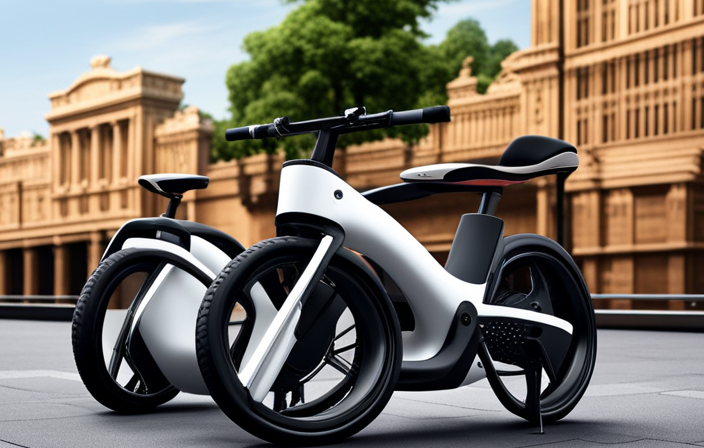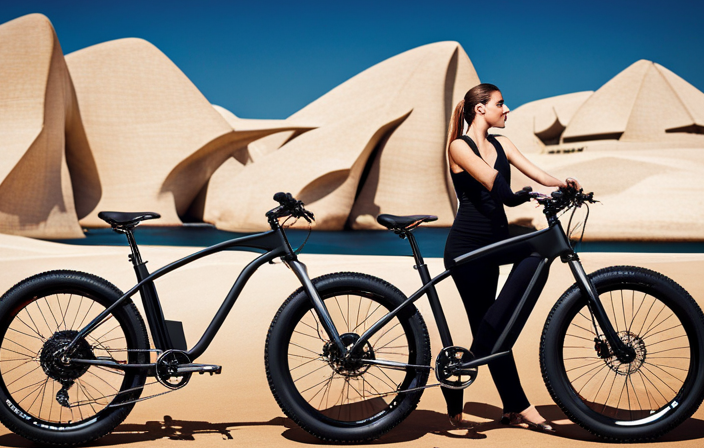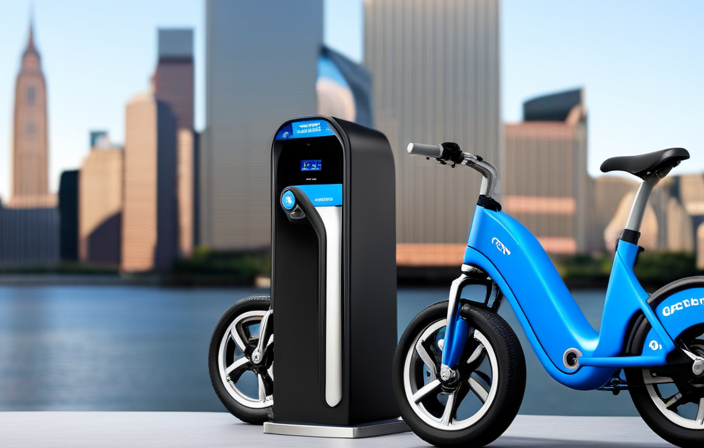Picture yourself cruising down the road on a sleek and powerful electric bike. As you glide effortlessly, you may wonder, ‘What is the average weight of an electric bike?’
Understanding the weight of an electric bike is crucial for selecting the right model that suits your needs. In this article, we will delve into the components that affect electric bike weight, common weight ranges, and the importance of weight when choosing an electric bike.
Get ready to embark on a technical and analytical journey into the world of electric bike weight.
Key Takeaways
- The average weight of an electric bike can vary depending on factors such as battery capacity, motor power, frame, wheels, and accessories.
- Electric bikes generally fall into three weight categories: lightweight (around 35 pounds), mid-weight (45-60 pounds), and heavyweight (over 60 pounds).
- Electric bike weight is important as it can affect control, maneuverability, range, battery life, portability, and storage convenience.
- Factors to consider when choosing an electric bike include intended use, terrain, user weight and fitness level, desired range and battery life, weight distribution, balance, and suitability for the intended terrain and impact of user weight on bike characteristics.
Components that Affect Electric Bike Weight
You’ll find that the components that affect the weight of an electric bike can vary greatly.
One of the main factors that affects the weight of an electric bike is the battery. Batteries can range in weight depending on their capacity and technology. A larger battery with a higher capacity will generally weigh more, but it will also provide a longer range and battery life.
Another component that affects the weight of an electric bike is the motor. Motors can vary in weight depending on their power output and technology. A more powerful motor will generally weigh more, but it will also provide better maneuverability and handling.
Other components such as the frame, wheels, and accessories can also contribute to the overall weight of an electric bike.
Now, let’s move on to the subsequent section about common weight ranges for electric bikes.
Common Weight Ranges for Electric Bikes
Typically, electric bikes fall within a range of weights. These common weight ranges can vary depending on several factors to consider.
-
Lightweight: Some electric bikes weigh as little as 35 pounds, making them easy to handle and maneuver. These bikes are ideal for those looking for a nimble ride or for those who may need to carry the bike up stairs or onto public transportation.
-
Mid-weight: The majority of electric bikes fall into this category, weighing between 45-60 pounds. These bikes strike a balance between weight and durability, offering a comfortable ride while still providing enough stability and power.
-
Heavyweight: On the higher end of the spectrum, there are electric bikes that weigh over 60 pounds. These bikes are designed for off-road adventures and long-distance rides, offering robust frames and powerful motors.
Considering the common weight ranges of electric bikes is important when choosing the right bike for your needs. This leads us to the next section, where we will discuss the importance of electric bike weight.
Importance of Electric Bike Weight
When considering the importance of electric bike weight, there are several key points to consider.
Maneuverability and handling are greatly affected by the weight of the bike, as a heavier bike may be more difficult to control and maneuver around tight corners or obstacles.
Additionally, the weight of the bike can impact the range and battery life, as a heavier bike may require more energy to operate and therefore have a shorter range.
Lastly, portability and storage are important factors to consider, as a lighter bike is easier to transport and store when not in use.
Maneuverability and Handling
Electric bikes are known for their smooth maneuverability and easy handling. The weight of an electric bike plays a crucial role in determining its maneuverability and stability. A lighter bike tends to be more agile and responsive, making it easier to navigate tight turns and corners. It allows for quick and effortless changes in direction, enhancing the overall riding experience.
On the other hand, a heavier bike can negatively impact performance and efficiency. It requires more effort to accelerate and decelerate, which can result in decreased battery life and reduced range. Therefore, finding the right balance between weight and stability is essential for optimizing the maneuverability and handling of an electric bike.
Transitioning into the next section about range and battery life, the weight of an electric bike also influences its energy consumption and overall efficiency.
Range and Battery Life
To optimize the range and battery life of your e-bike, it’s important to consider factors such as the weight and efficiency of the vehicle. Battery technology plays a crucial role in determining the overall weight of an electric bike. Here are four key aspects to consider regarding range and battery life:
-
Battery Capacity: The higher the battery capacity, the longer your e-bike can travel before needing a recharge.
-
Battery Type: Different battery chemistries have varying energy densities, affecting the weight and range of your e-bike.
-
Motor Efficiency: An efficient motor consumes less power, extending the battery life and increasing the range.
-
Regenerative Braking: This feature allows the e-bike to recharge its battery while braking, enhancing overall range.
Considering these factors can help you choose an electric bike with optimal range and battery life.
Moving forward to the next section on portability and storage, it’s crucial to ensure your e-bike is easy to transport and store without compromising its performance.
Portability and Storage
For optimal convenience, make sure your e-bike is easily transportable and storable without sacrificing performance. Portability benefits are crucial when it comes to electric bikes. Being able to easily transport and store your e-bike allows for greater flexibility in your daily commute or recreational activities. A lighter weight e-bike will make it easier to carry and maneuver, especially when you need to navigate through crowded streets or transport it in a vehicle. Additionally, weight distribution is another important factor to consider. A well-balanced e-bike with evenly distributed weight will provide better stability and handling, ensuring a safer and more enjoyable riding experience. To illustrate this point, consider the following table:
| Portability Benefits | Weight Distribution |
|---|---|
| Easy to transport | Even weight balance |
| Convenient storage | Stable and agile |
Considering these factors, it is important to choose an e-bike that offers both portability benefits and optimal weight distribution. This will ensure a comfortable and efficient ride. Moving forward, let’s explore the factors to consider when choosing an electric bike.
Factors to Consider When Choosing an Electric Bike
When choosing an electric bike, there are several factors that you should consider.
First, think about your intended use and the terrain you will be riding on. This will help determine the type of electric bike that is best suited for your needs.
Second, consider your own weight and fitness level as this will impact the performance and efficiency of the electric bike.
Lastly, take into account the desired range and battery life of the electric bike to ensure it meets your specific requirements.
By considering these factors, you can make an informed decision and find the perfect electric bike for you.
Intended Use and Terrain
If you plan on riding mostly on flat terrain, an electric bike would be a great choice for you. When considering an electric bike for flat terrain, one important factor to consider is the weight distribution of the bike. Electric bikes typically have a heavier frame due to the inclusion of a motor and battery. This added weight can affect the bike’s performance, especially when it comes to maneuverability and acceleration.
A bike with a more evenly distributed weight will provide better stability and control on flat terrain. Additionally, the weight of the bike can impact the overall efficiency and range of the battery. It’s essential to choose an electric bike with an optimal weight distribution to maximize performance.
Moving on to the next section about user weight and fitness level, it is important to consider these factors as well.
User Weight and Fitness Level
Now let’s delve into the impact of user weight and fitness level on electric bikes. These factors play a crucial role in determining the average weight of an electric bike. A heavier user will require a bike with a higher weight capacity to ensure optimal performance and safety. Additionally, user weight can affect the bike’s range and battery life, as it directly influences the energy consumption. Furthermore, the fitness level of the rider correlates with the power assistance required from the electric motor. A fitter individual may require less assistance, resulting in longer battery life and improved range. To better visualize this relationship, consider the following table:
| User Weight | Fitness Level |
|---|---|
| Light | Low |
| Medium | Moderate |
| Heavy | High |
Understanding the impact of user weight and fitness level is crucial for choosing an electric bike that aligns with your specific needs. Moving forward, let’s explore the desired range and battery life.
Desired Range and Battery Life
To ensure your electric bike meets your needs, it’s important to consider your desired range and battery life.
The desired range refers to how far you want to be able to ride on a single charge. This will depend on your daily commute or the distance you plan to cover during your rides.
You should also take into account the battery efficiency of the electric bike. A higher battery efficiency means that the bike will be able to go further on each charge. Factors that affect battery efficiency include the motor power, weight of the bike, and the terrain you will be riding on.
By considering both the desired range and battery efficiency, you can find an electric bike that will meet your needs for longer rides.
Now, let’s explore some tips for reducing electric bike weight.
Tips for Reducing Electric Bike Weight
When looking to reduce the weight of your electric bike, there are several key points to consider.
First, you should focus on choosing lightweight components such as carbon fiber or aluminum. These materials will help to significantly decrease the overall weight of your bike.
Additionally, opting for a smaller battery can also help to reduce weight while still providing sufficient power for your rides.
Finally, considering the frame material and design is essential as certain materials, like titanium, are known for being lightweight yet strong.
Overall, by paying attention to these factors, you can effectively reduce the weight of your electric bike without compromising its performance.
Choosing Lightweight Components
For a lighter electric bike, you can choose lightweight components. By opting for lightweight frame materials such as carbon fiber or aluminum, you can significantly reduce the overall weight of your bike. These materials are not only lightweight but also offer excellent strength and durability. Additionally, minimizing unnecessary accessories like fenders, racks, and lights can further lighten your bike. When selecting components, prioritize those made from lightweight materials such as titanium or high-strength alloys. To give you an idea of the weight savings, take a look at the table below:
| Component | Weight (grams) | Weight Savings (grams) |
|---|---|---|
| Carbon Fiber Fork | 600 | 200 |
| Titanium Pedals | 200 | 100 |
| Aluminum Handlebars | 300 | 150 |
| High-Strength Alloy Crankset | 500 | 250 |
| Lightweight Saddle | 250 | 75 |
By choosing lightweight components, you can significantly reduce the weight of your electric bike and enhance its performance. This weight reduction allows for better maneuverability and improved efficiency. Opting for a smaller battery is another way to further decrease the weight of your bike.
Opting for a Smaller Battery
Opting for a smaller battery can help reduce the overall weight of your e-bike. When choosing a battery for your electric bike, consider the trade-off between battery size and weight. A smaller battery means less energy storage capacity, but it also means a lighter overall bike.
Lithium-ion batteries are commonly used in electric bikes due to their high energy density and lightweight properties. By opting for a smaller battery with a lower capacity, you can significantly decrease the weight of your e-bike without compromising its performance.
Additionally, there are other weight reduction techniques to consider, such as using lightweight components and considering frame material and design. These factors play a crucial role in minimizing the weight of your electric bike while maintaining its structural integrity and functionality.
Transitioning into the subsequent section, considering frame material and design is another essential aspect to achieve a lightweight e-bike.
Considering Frame Material and Design
One important factor to consider when choosing a frame material and design is their impact on the overall weight of your e-bike. Different frame materials, such as aluminum, carbon fiber, and steel, have varying weights and properties.
Aluminum frames are lightweight and durable, making them a popular choice for electric bikes. Carbon fiber frames are even lighter than aluminum but are more expensive. Steel frames, on the other hand, are heavier but offer greater strength and durability.
Weight distribution analysis is also crucial in determining the overall weight of the e-bike. A well-designed frame can distribute the weight evenly, ensuring better stability and control during rides.
By carefully considering frame material and design, you can optimize the weight of your electric bike without compromising on performance.
Transitioning into the future of electric bike weight, advancements in technology continue to drive innovations in frame materials and designs, aiming for even lighter and more efficient e-bikes.
The Future of Electric Bike Weight
The Future of Electric Bike Weight looks promising, as manufacturers are working on reducing the overall weight to improve performance. With future developments and technological advancements, electric bikes are expected to become even lighter and more efficient.
One area of focus is the use of advanced materials, such as carbon fiber, which are known for their lightweight and durable properties. These materials are being incorporated into the design of electric bike frames, allowing for a significant reduction in weight without compromising strength.
Additionally, advancements in battery technology are also contributing to the reduction of weight. Lithium-ion batteries, for example, are becoming smaller and lighter while still providing a high energy density.
As manufacturers continue to invest in research and development, the future of electric bike weight holds great potential for lighter, faster, and more agile rides.
Frequently Asked Questions
Are electric bikes heavier than regular bikes?
Yes, electric bikes are typically heavier than regular bikes due to the additional weight of the battery and motor. On average, electric bikes can weigh around 45-70 pounds, whereas regular bikes usually weigh between 20-30 pounds.
Can I ride an electric bike if I’m overweight?
Yes, you can ride an electric bike even if you’re overweight. Electric bikes provide pedal-assist, making it easier for you to ride. Regular exercise on an electric bike can improve your overall health and provide cardiovascular benefits.
How much does the battery of an electric bike weigh?
The weight of an electric bike battery varies depending on the model and capacity. On average, electric bike batteries weigh between 5 to 10 pounds. The battery lifespan can range from 500 to 1,000 charge cycles, and the charging time typically takes around 3 to 6 hours.
Do heavier electric bikes require more maintenance?
Heavier electric bikes do require more maintenance due to the increased strain on components. The weight directly impacts battery life, as it requires more power to propel a heavier bike. Performance is also affected, with slower acceleration and reduced range.
Are there any regulations regarding the weight of electric bikes?
There are regulations on electric bike weight limits in certain countries. For example, in the European Union, electric bikes are limited to a maximum weight of 55 kg, including the battery. Other regions may have their own weight restrictions on electric bikes.
Conclusion
In conclusion, when it comes to the average weight of an electric bike, there are several factors to consider.
The weight of an electric bike can range from around 40 to 80 pounds, depending on the components and materials used.
It is important to choose an electric bike that suits your needs and preferences, taking into account factors such as power, range, and terrain.
Interestingly, studies have shown that reducing the weight of an electric bike by just 10% can increase its efficiency by up to 10%.
This means that even small reductions in weight can have a significant impact on the performance of an electric bike.
As technology continues to advance, we can expect to see further developments in electric bike weight, making them even lighter and more efficient in the future.









